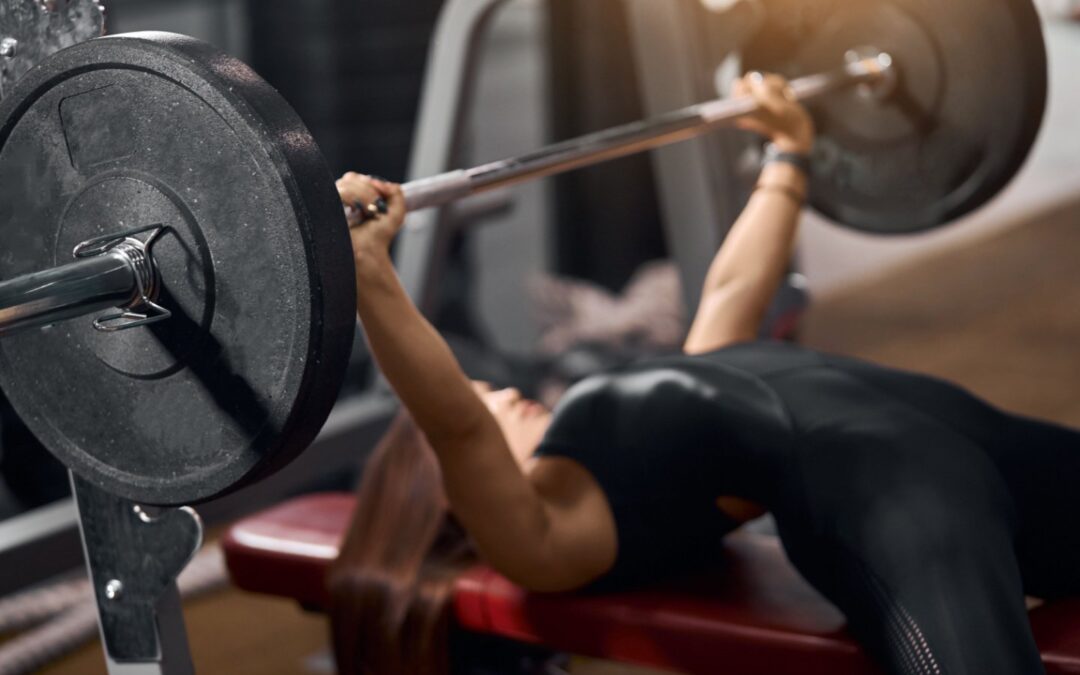In some gym circles, you’re not considered a “true” lifter if nobody has ever asked you, “How much do you bench?” This fundamental exercise is the archetypal test of upper body strength and size.
Yet, you might’ve seen this scene happen in person or in a viral video: a powerlifter marches toward a bench press station, folds themselves like a Cirque du Soleil acrobat, and proceeds to lift a seemingly impossible weight using the shortest possible range of motion. On the other side, you see big lifters moving big weights while lying on the bench as flat as a flounder.
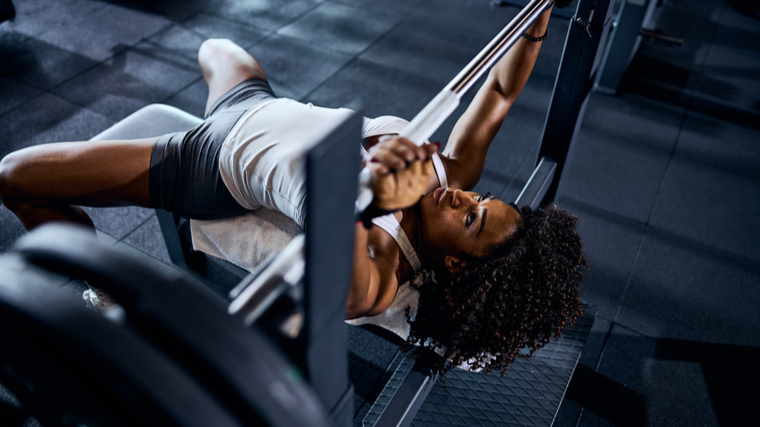
So, who’s right or wrong? Is one of these lifters even “wrong?” Here’s a review of the benefits and risks of performing the bench press with an arch, as well as how and when to use this modified technique to reach your goals.
The Importance of a Bench Press Arch
Benefits of Using an Arch
The bench press arch refers to the deliberate extension and curvature of your spine when lying on the flat bench. A little arch is natural with most people, as it simply follows the natural curve of the spine, which isn’t flat.
You can easily spot an arch, as the lower back of the lifter is not touching the bench. If someone has an exaggerated spine curvature — for instance, a lordosis — they are forced to arch. Some lifters, especially powerlifters in competition, try to amplify this curvature and have as big an arch as possible. Why? It has several benefits, especially if you want to get stronger.
More Weight Lifted
With a bigger arch, the lower portion of your chest is in a higher position. This means that the point of contact with the barbell will be higher and, as such, the range of motion will be shorter. For the same amount of force produced, you can lift more weight. If you want to increase your bench press, then learning how to arch is an excellent way of improving the efficiency of your lift.
This method became so effective that some powerlifters would seem to barely make the barbell move more than a few inches and, as result, would set incredible records. Many would even say it’s cheating, ridiculous, and defeats the purpose of the sport.
3 Powerlifters With The Biggest Arch
As such, some powerlifting federations, like the International Powerlifting Federation — the biggest tested powerlifting federation in the world — updated their competition rules to limit arching. The goal was to ensure that performance is primarily based on a lifter’s strength, and not their mobility.
Safer on the Shoulders
Your shoulders are some of the most mobile and most fragile joints in your body. They are put under a lot of stress with the bench press. Arching your back allows you to better squeeze your shoulders blades together and down, and maintain them in place during execution of the exercise.
Because the range of motion is shorter with an arched bench press, your elbows travel a shorter distance into the bottom position and will not go as far beneath your shoulder joint. This prevents excessive stretching in your shoulders and chest muscles, while avoiding a relatively weaker position that might result in injuries or joint strain. This is especially important if you have longer arms, as these effects are amplified.
More Overall Stability
Arching your back makes your upper body more “compact” and creates more full-body tension by strongly activating your upper back, lat, hips, and core muscles, compared to lying flat on the bench.
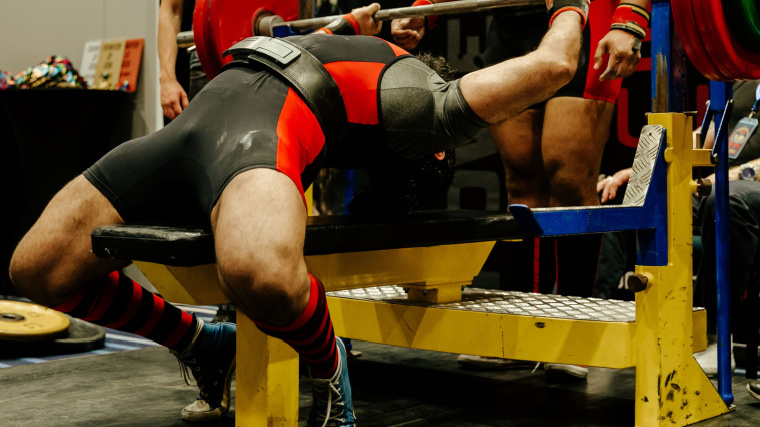
This way, you can properly distribute the energy from your legs through your torso to your shoulders and into the barbell. If your whole body is tensed, you will provide a more stable surface from which to press.
It’s the same principle that makes squatting with your feet on the floor easier than standing on a stability ball — you can generate more force without having to balance your body. If your torso wiggles on the bench with each repetition, you’re bound to leak strength and decrease your rate of technical adaptation.
More Muscle Growth
This is perhaps the most surprising benefit, as most gym veterans swear that the arched bench press should only be used by powerlifters focused on strength, and that a flatter version is better for muscle mass. But studies have shown more back and triceps activation during the arched bench press. (1) That’s logical, as the lats help arch the back, and a shorter range of motion will put more stress on your arms.
But what about building your chest? People have claimed that the arched bench turns the lift into some sort of decline bench press and that’s somewhat true, as lower chest activation is slightly greater. But upper chest activation remained the same, so muscle recruitment is still net-positive, likely because you can use more weight. So overall, you activate more muscle mass and stimulate more growth.
Risks of Using an Arch
With all these perks, arching seems too good to be true. There might be some risks, though, especially if you exaggerate it too much. You can have too much of a good thing.
Lower Back Strain
Your spine is naturally extended because of its curvature, but extreme extension will put the disks and nerves at a greater risk of injury. Sure, there’s no axial loading or shear forces, but the technique will still put some stress on your lower back, especially if you then use leg drive to generate full-body tension. The probabilities of injuries may be relatively low, but you should keep them in mind, especially if you have pre-existing back issues.
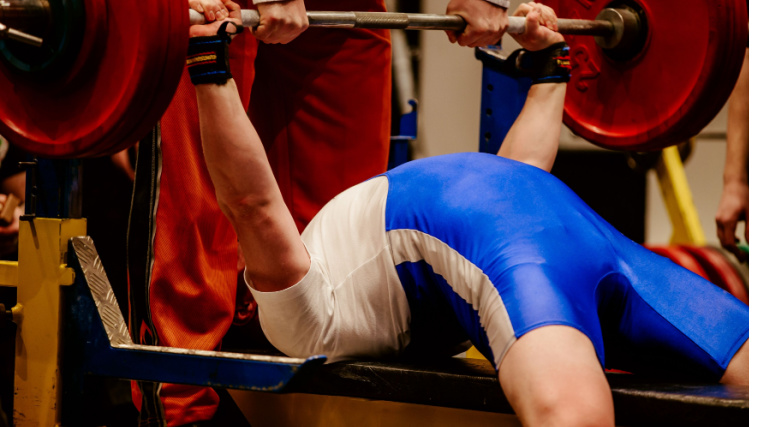
A hernia could even potentially happen, even though it usually occurs during spinal flexion (bending forward at the waist). If you already have lower back troubles or injuries, arching might prove very painful and counterproductive. If you’re such a lifter, you should refrain from using a powerlifting arch and stick to maintaining your natural arch or pressing with a flatter back, depending on which is least painful.
Less Muscle Mass
But, didn’t we just say that an arched back recruits more muscle mass? Indeed, but there’s arching and there’s arching. If you cut the range of motion too much, some muscles will be less stimulated. The more a muscle is stretched, the more it responds to training. (2) And if there’s almost no stretch due to an extremely limited range of motion, the stimulus will be much lower.
Using some partial movements here and there is not a problem, but they shouldn’t make up the bulk of your training. If your training is minimalist — using a limited variety of exercises or very low volume — you should probably abstain from using a big arch. Or, if you do bench with an arch, make sure you’re also including full-range exercises like the incline bench press and overhead press to really complete your training and fill out your physique.
How to Arch
Most people already have a natural arch, this is just how they’re built. If you want to stick to a natural arch when performing a bench press, simply squeeze your shoulders blades together and down, and puff your chest up and high. But if you want to maximize your arch (either because you naturally don’t have one or you want to lift as heavy as possible), follow these steps.
Step 1 — Setup on the Bench
Lay down on the bench, grab the barbell, and grip the bar outside of shoulder-width. Your eyes or eyebrows should be directly in line with the bar. Squeeze your shoulders blades together and down (toward your glutes) as far as possible. Try to feel your traps dig into the bench. Focus on arching your upper back as much as possible, not necessarily your lower back.

If you want to take things to the max and really optimize your position, you can even put your feet on the bench while setting up your initial position. This will put as much weight as possible on your traps and will help to leverage your body into position.
Step 2 — Set Your Stance
If they were up on the bench, put your feet on the floor while keeping your arch. Position your feet as close to your shoulders as possible. Start “digging” your heels backward as far as you comfortably can.
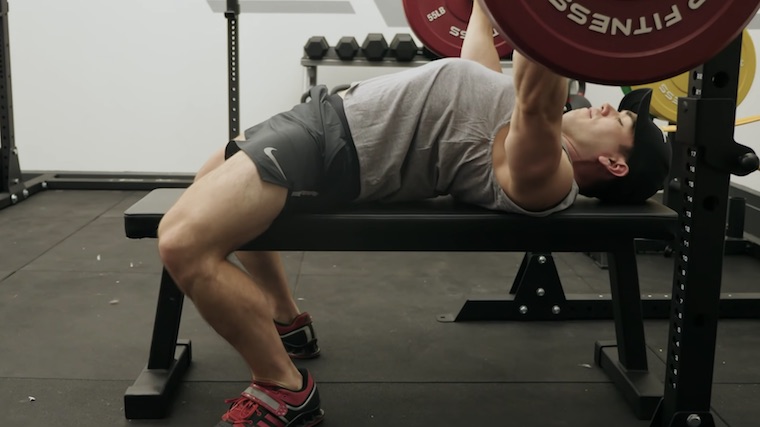
Push your toes into the ground “down and away” from your body. This lower body pushing motion will help you prevent your glutes from rising off the bench.
Step 3 — Unrack the Bar, Lower, and Press
Maintain pressure through your feet. Unrack the barbell, with the help of a spotter if possible. Once the bar is set at the midway point, just above your chest, pause very briefly to confirm proper positioning.
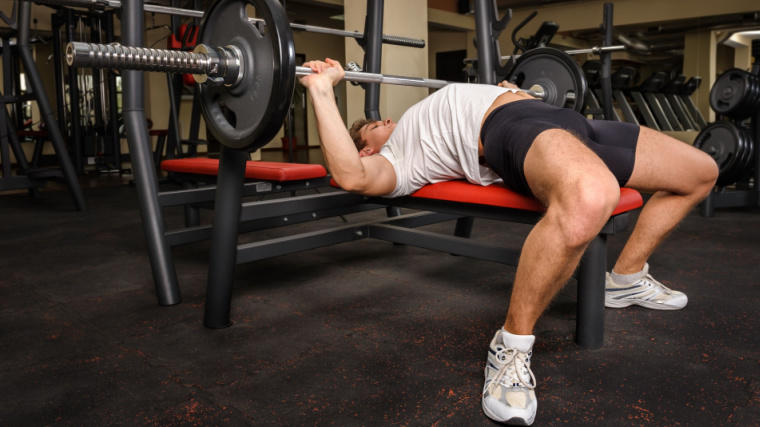
Keep applying full-body tension from your traps to your toes. Lower the barbell until it gently touches your chest. Feel tension in your upper body at all times and hold your chest high. Move the weight deliberately and cautiously because the range of motion will be less than what you may be used to. As you feel the bar make contact, press powerfully to lockout.
How to Improve Your Arch
The bench press is an unnatural movement in itself — lying on a short platform while repeatedly moving a long, heavy bar above your rib cage and several vital organs. Intentionally arching your upper body during the exercise can feel even more unnatural.
Your first attempts to use an arch will likely feel awkward and certainly won’t be perfect. Also, unfortunately for the stiffer lifters out there, there’s a dose of mobility involved. Some will never develop a really big arch, but you can still improve it following these suggestions.
Dynamic Foam Rolling
Before you lift, after a general warm-up, grab a foam roller and start hammering your mid-back for a minute. This upper body drill is key for thoracic mobility.
Foam Rolling for the Thoracic Spine
Loosening your spinal erectors, running the full length of your back, will also help tremendously with improving your arch position. Don’t forget to also, carefully, roll your lower back. This will help hold your position when your lower body is set and creating tension.
Knee Raises or Leg Raises
Why should you do a few sets of an ab exercise before benching? Well, these movements also greatly stimulate your hips flexors. If you perform ab work with a full, smooth range of motion, those hip flexors will loosen. Tight hips flexors will prevent you from pulling your feet into position on the floor, which will prevent you from getting into a deep arch position.
Face Pulls and Postural Exercises
Because of the generally sedentary modern lifestyle, most people are more prone to a kyphotic (rounded shoulder), caveman-style posture. This can increase the risk of bench press injuries, but also prevent you from adopting a great arch. You simply won’t be able to open your chest as much.
Industrial Athletic Strength Band Shoulder Dislocation
A great warm-up before benching would be to grab a light resistance band and perform face pulls, pull-aparts, and the over-and-back (sometimes intimidatingly called “shoulder dislocates”). These exercises will strengthen your rotator cuff and, more importantly, improve your posture which carries over to your arch.
Bench Thoracic Spine Stretch
Stretching after your session is never a bad idea, but you could even do some static stretching before your bench. This can be especially useful in the most extreme cases of bad posture or mobility restrictions. There are several options available, but here’s one of the most effective.
Bench T-Spine Extension | Thoracic Extension
Kneel down in front of a flat bench or a box. Place your elbows on the bench and bend your elbows to aim hands up in the air. Slowly lean your body down until your head passes between, and under, your upper arms. Move as far as comfortably possible.
To accentuate the stretch, bring your hands towards your traps or the back of your neck (without pressing down). Hold the stretch for 45 to 60 seconds.
Big Arch for a Big Bench
Prejudice, misinformation, and a few bad apples have given the bench press arch a bad rep, but there are actually many benefits. If you can ignore the comments you might get from other lifters about “the right way” to bench, give it a try and watch your performance improve, your muscles grow, and your shoulder pain diminish.
References
- Alan C. Cudlip, Jacquelyn M. Maciukiewicz, Brendan L. Pinto & Clark R Dickerson (2022) Upper extremity muscle activity and joint loading changes between the standard and powerlifting bench press techniques, Journal of Sports Sciences, 40:9, 1055-1063, DOI: 10.1080/02640414.2022.2046937
- Alan C. Cudlip, Jacquelyn M. Maciukiewicz, Brendan L. Pinto & Clark R Dickerson (2022) Upper extremity muscle activity and joint loading changes between the standard and powerlifting bench press techniques, Journal of Sports Sciences, 40:9, 1055-1063, DOI: 10.1080/02640414.2022.2046937
Featured Image: UfaBizPhoto / Shutterstock

